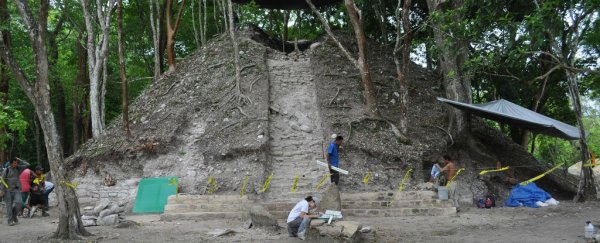An international team of archaeologists working in Belize has uncovered one of the biggest royal Maya tombs ever, containing a male corpse, animal bones, obsidian blades, and hieroglyphic panels that offer new insights into the legendary 'snake dynasty'.
The team uncovered the tomb in Xunantunich, an ancient city in Western Belize that once served as a ceremonial centre for the Maya, under the stairway of a temple.
"In other words, it appears that the temple was purposely erected for the primary purpose of enclosing the tomb," team leader Jaime Awe from Northern Arizona University told Alan Yuhas from The Guardian. "Except for a very few rare cases, this is not very typical in ancient Maya architecture."
According to the team, the tomb was built for a 20- to 30-year-old muscular man, who must have been of some importance, though they're still trying to figure out more information about his life.
Alongside his remains, the researchers found the bones of a jaguar and a deer, jade beads that might have been a necklace, 13 obsidian blades, and 36 ceramic vessels. In another area of the tomb, they also found two 'offering caches' that contained nine obsidian blades and 28 flint figurines that were carved into various symbols and animals, Yuhas reports.
While finding a tomb is always exciting for archaeologists, this one is particularly special, because it's one of the biggest Maya tombs ever found in Belize, measuring in at 4.5 metres (14.7 feet) by 2.4 metres (7.9 feet).
"What's amazing about the discovery of this tomb is that we know that archaeologists have been working at Xunantunich since the 1890s," Awe told Julia Arzu from The Reporter.
"That's more than a century of continuous archaeological work at the site. And, never before have we found a tomb. Well, this tomb is also remarkable in other ways, it is one of the largest burial chambers we have ever found."
The most important find inside the tomb could be the inscribed panels featuring hieroglyphics related to the so-called snake dynasty – a family that ruled the Maya empire some 1,300-years-ago, and used a snake-head emblem as their symbol.
The team's epigrapher, Christophe Helmke from the University of Copenhagen in Denmark, says these panels tell of the conquests of Lord K'an II – the ruler of the ancient city of Caracol, which was located roughly 41 kilometres (26 miles) south of the tomb.
But, oddly enough, the hieroglyphics might also reveal another king from the snake dynasty named Waxaklajuun Ubaah K'an, who likely ruled sometime around 635 AD. The team says this find suggests that there could have been two kings – possibly brothers – vying for the throne.
"This means that there were two contenders to the throne, both carrying the same dynastic title, which appears to have been read Kanu'l Ajaw, 'King of the place where snakes abound'," Helmke told The Guardian.
With the help of these panels, the researchers hopes to glean more information about the snake dynasty, and by piecing together the royal family's history, they might also shed new light on the fall of the entire Maya civilisation.
The team's findings have been published in the Journal of the Pre-Columbian Art Research Institute.
